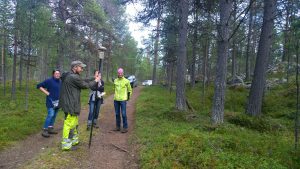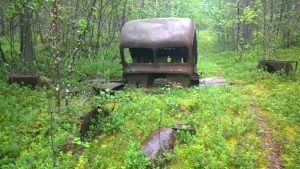Kaikki paikat yleisökaivauksille ovat täyttyneet ja ilmoittautuminen on suljettu. Kiitos kiinnostuksesta.
The registration is full and closed. Thank you for your interest.
 Oula Seitsonen, Suzie Thomas, Anu and Vesa-Pekka Herva tutkimassa vankileiriä Inarin Kankiniemessä 2015. Kuva: Eerika Koskinen-Koivisto.
Oula Seitsonen, Suzie Thomas, Anu and Vesa-Pekka Herva tutkimassa vankileiriä Inarin Kankiniemessä 2015. Kuva: Eerika Koskinen-Koivisto.
Lapin synkkä kulttuuriperintö -projekti (Helsingin ja Oulun yliopistot) ja saamelaismuseo Siida järjestävät yhdessä yleisökaivaukset toisen maailmansodan aikaisella saksalaisten sairaala-alueella Inarissa 1.–5.8.2016. Toivotamme vapaaehtoiset tervetulleiksi ottamaan osaa kaivauksiimme, joko yhdeksi päiväksi tai vaikka koko viikon ajaksi (päivittäinen kaivausaika klo 10–12 ja 13–15).
Kaikkien vapaaehtoisten tulee rekisteröityä ilmoittautumislomakkeella (alle 16-vuotiaat voivat osallistua kaivaukseen vain huoltajan seurassa; huoltaja rekisteröi myös heidät kaivaukselle, kts. ilmoittautumislomake). Kaivaukseen pystyy osallistumaan 10 vapaaehtoista päivässä, ja paikat täyttyvät ilmoittautumisjärjestyksessä. Kaivamisen lisäksi tarjolla on päivittäin asiantuntijoiden pitämiä yleisöluentoja, opastuksia ja muuta ohjelmaa.
Vapaaehtoiset tulevat ottamaan aktiivisesti osaa Lapin sodan aikana vuonna 1944 poltetun saksalaisten sotilassairaala-alueen raunioiden kaivamiseen ja dokumentoimiseen yhdessä Helsingin ja Oulun yliopistojen sekä Siida-museon kokeneiden ammattiarkeologien kanssa. Projektin johtaja Vesa-Pekka Herva ja tutkija Oula Seitsonen ovat työskennelleet Lapin toisen maailmansodan aikaisen kulttuuriperinnön parissa vuodesta 2007 lähtien. Vapaaehtoisten tulee järjestää oma asumisensa (Inarissa on useita majoitusvaihtoehtoja, voimme tarvittaessa auttaa tässä) sekä päivittäinen kulkemisensa kaivauspaikalle.
 Auton raato saksalaisella sairaala-alueella Inarissa. Kuva: Eerika Koskinen-Koivisto.
Auton raato saksalaisella sairaala-alueella Inarissa. Kuva: Eerika Koskinen-Koivisto.
Projektimme tutkii Lapin toisen maailmansodan kulttuuriperintöä monitieteisesti arkeologian, historian ja kansatieteen näkökulmista. Toisen maailmansodan aikaisia sairaala-alueita ei ole aiemmin tutkittu arkeologisesti Suomessa tai muuallakaan Euroopassa: konfliktiarkeologiset tutkimukset ovat yleisimmin keskittyneet sotilaallisempiin kohteisiin, kuten puolustusasemiin ja sotilas- sekä vankileireihin. Tiedämme haastatteluista, että saksalaisten sotilaiden lisäksi kohteella hoidettiin myös inarilaisia ja kohde on tärkeä osa paikallista kulttuuriperintöä: paikkakuntalaiset ovat tunteneet kohteen aina, mutta kulttuuriperintöviranomaisilla ei ollut mitään tietoa kohteesta ennen vuotta 2015.
Kesän 2016 tutkimusten päätavoitteina on dokumentoida ja analysoida kohteen rakenteita ja tilanjakoa sekä tutkia millaista esineellistä materiaalia kaivauksissa löytyy. Tutkimusprojekti pyrkii selvittämään moninaisia kulttuurisia merkityksiä ja arvoja, joita saksalaisten toisen maailmansodan aikaiseen kulttuuriperintöön on liitetty ja liitetään. Pohjois-Suomen toisen maailmansodan kulttuuriperinnön merkittävyyttä arvioidaan osana Lapin alueen laajempaa historiallista, kulttuurista ja ympäristöllistä vuorovaikutusta.
On tärkeää, että vapaaehtoiset ilmoittavat rekisteröityessään mahdollisista sairauksista tai lääkityksistä, jotka voivat vaikuttaa hyvinvointiin kaivauksilla, sillä kaivaminen on fyysisesti kohtalaisen vaativaa. Osallistujilla tulee olla voimassaoleva vapaa-ajan tapaturmavakuutus, joka kattaa mahdolliset henkilökohtaiset vahingot, sekä viimeisen 10 vuoden kuluessa annettu jäykkäkouristusrokote. Kaikkia osallistujia pyydetään myös allekirjoittamaan suostumuslomake osallistumisesta tieteelliseen tutkimukseen. Kaivauksiin osallistuminen maksaa 5 € / päivä tai 20 € koko viikko. Osallistumismaksu kattaa kaivauskulut, välineet ja päiväkahvit.
Lisätietoa sähköpostilla DarkHeritageLapland[at]gmail.com tai puhelimitse Oula Seitsonen: +35850 448 7778 / oula.seitsonen(at)helsinki.fi
 Kenttäkeittimen jäänteitä maastossa. Kuva: Eerika Koskinen-Koivisto.
Kenttäkeittimen jäänteitä maastossa. Kuva: Eerika Koskinen-Koivisto.
Public excavations at a Second World War German military hospital site in Inari 1.-5.8.2016
Lapland’s Dark Heritage research project (Universities of Helsinki and Oulu) is organizing, together with the Siida Sámi Museum, a public excavation at a Second World War (WWII) German hospital site in Inari, Lapland, on 1.–5.8.2016. We welcome volunteers to take part in the excavations, either on one or more of the days or all week (excavation daily 10–12 am and 1–3 pm).
All volunteers need to pre-register (volunteers under the age of 16 have to be accompanied by a responsible adult who also registers them, see the registration form). We can accommodate up 10 participants per day at the excavations, and places will be filled on a first come, first served basis. Besides excavation, there is a daily programme of other events, such as public presentations by specialists and special guided tours (TBC).
We invite volunteers to participate in uncovering and documenting the remains of a German military hospital site which was destroyed and burned in 1944, during the Lapland War. They will excavate alongside, and be guided by, professional archaeologists from the Universities of Oulu and Helsinki and Siida Museum, who have been working with WWII sites in Lapland since 2007. Volunteers need to arrange their own accommodation (there are several choices in Inari, if needed, we can help with that) and organize their daily transport to and from the site.
The research project draws from multidisciplinary study of Lapland’s WWII heritage, including archaeological, historical and ethnographical aspects. WWII hospital sites have never been archaeologically explored before in Finland, or elsewhere in Europe for that matter: earlier ‘conflict archaeology’ studies have typically concentrated on more martial sites, such as fortifications and military and prisoner-of-war camps. We know from interviews that, besides German soldiers, Inari villagers were also treated at the hospital by German doctors and nurses, and the site forms a pertinent part of the local heritage. The site has always been known to the locals, but it was not known to the heritage authorities before 2015.
The main aims of the excavation in Inari are to document and analyze the spatial layout of the site, and to explore the kinds of material culture that will show up. The project also seeks to understand the diverse cultural values and meanings associated with the material heritage from the German military presence in Lapland. As part of this we will be talking to the volunteers about their thoughts and impressions while they are on site. The significance of northern Finland’s WWII heritage will be considered broadly against Lapland’s wider historical, cultural and environmental context.
It is important that, when registering, you mention any medical requirements and conditions that might affect your well-being at the site: excavation work is physically moderately demanding. Participants need to have valid insurance covering any personal accidents on site, and have to confirm that they have been vaccinated against tetanus within the past 10 years. All participants are also asked to sign a consent form at the site. The participation fee is 5 € / day or 20 € for whole week. The fee covers excavation gear, tools and coffee.
For more information, contact DarkHeritageLapland[at]gmail.com or Oula Seitsonen: +35850 448 7778 / oula.seitsonen(at)helsinki.fi.





